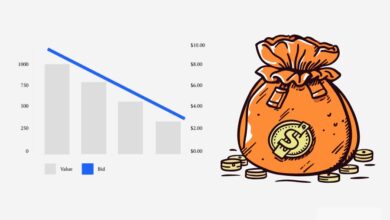
Should You Bid on Your & Competitors Branded Terms?
Should you bid on your and competitors branded terms – Should you bid on your and competitors’ branded terms? This crucial question in online advertising demands careful consideration. Understanding your brand, analyzing competitors, and evaluating potential benefits and drawbacks are vital for a successful strategy. This exploration dives into the intricacies of branded term bidding, examining the advantages, disadvantages, and strategic approaches needed for optimal results.
We’ll explore what constitutes a branded term, how to identify competitor strategies, the potential upsides and downsides of bidding on both your and their branded terms, and finally, how to develop a strategic bidding framework. By the end, you’ll have a clear picture of whether and how to incorporate branded terms into your advertising campaigns.
Understanding Branded Terms
In the ever-evolving world of online advertising, understanding the nuances of search terms is crucial for effective campaigns. One critical aspect of this understanding is the difference between generic and branded terms, and how they impact bidding strategies. This section delves into the specifics of branded terms, explaining their characteristics, types, and significance in the digital marketing landscape.Branded terms are search queries that directly reference a specific brand, product, or service.
They represent a powerful signal of intent, as users actively seeking information or products associated with a particular brand are more likely to be ready to make a purchase or take a desired action. Understanding how to leverage these terms effectively is key to optimizing your online advertising campaigns.
Defining Branded Terms
Branded terms are search queries that explicitly mention a brand name, product name, or service name. They are a critical component of online advertising, as they often signal a high level of user intent. These terms can be categorized into various types, each with its own characteristics and implications for online advertising strategies.
Brand Terms vs. Generic Terms
Brand terms are search queries that explicitly reference a brand. Generic terms, on the other hand, describe a product or service category without referencing a specific brand. For example, “Nike shoes” is a branded term, while “running shoes” is a generic term. The crucial difference lies in the level of intent. Users searching for branded terms are often more likely to be actively considering a purchase, while users searching for generic terms may be in a much earlier stage of the decision-making process.
Types of Branded Terms
Various types of branded terms exist, each with unique implications for advertising strategies. These include:
- Company Name: The most fundamental branded term, referencing the overall brand itself (e.g., “Google”).
- Product Name: Specific products offered by the brand (e.g., “iPhone 14”).
- Specific Service Names: Services provided by the brand (e.g., “Netflix subscription”).
- Brand-related Phrases: Terms that reference specific aspects of the brand or products, often used in search queries (e.g., “Amazon Prime benefits”).
Characteristics of Branded Terms
Understanding the characteristics of branded terms helps in developing effective targeting strategies.
| Characteristic | Description | Example |
|---|---|---|
| Length | Branded terms can vary in length, from short and concise to longer, more descriptive phrases. | “Nike” vs. “Nike running shoes” |
| Complexity | Branded terms can range from simple brand names to complex phrases that include product attributes. | “Apple” vs. “Apple MacBook Pro 14 inch” |
| Common Usage Patterns | Patterns of usage can reveal seasonal trends, new product releases, or specific promotional periods. | Increased searches for “iPhone 14” during its release period. |
Competitive Landscape Analysis
Understanding your competitors’ strategies, particularly their use of branded terms in online advertising, is crucial for effective bidding and campaign optimization. A thorough analysis reveals their strengths, weaknesses, and potential opportunities, allowing you to refine your own approach and potentially gain a competitive edge. This section delves into methods for identifying, tracking, and analyzing competitor use of branded terms in various advertising channels.Analyzing competitor strategies provides valuable insights into their marketing approach, helping you understand their target audience, their advertising budget, and their campaign objectives.
This knowledge is instrumental in shaping your own marketing strategy, ensuring your campaigns are well-positioned against the competition and driving optimal results.
Deciding whether to bid on your own and competitor’s branded terms can be tricky. It often comes down to running controlled experiments to see what works best for your specific business. To do this effectively, you need to master the art of running adwords experiments like pro. Run AdWords experiments like pro to determine if you should bid on those keywords and gain a competitive edge.
Ultimately, a well-structured bidding strategy tailored to your unique situation is key to successful campaigns.
Identifying Competitor Branded Terms in Online Advertising
Competitor analysis requires identifying the specific branded terms they utilize in their online advertising campaigns. This involves a multi-faceted approach that includes examining their search engine advertising (SEA) campaigns, social media advertisements, and website content.
Tracking Competitor Use of Branded Terms in SEA and Social Media
Several tools and techniques can be employed to monitor competitors’ use of branded terms in search engine advertising and social media advertising. Utilizing research tools allows for a comprehensive view of competitors’ strategies, revealing the specific terms they target. Platforms like SEMrush, Ahrefs, and similar tools provide detailed data on competitors’ usage in paid search campaigns.
Deciding whether to bid on your own and competitor’s branded terms is a tricky one. It often comes down to your overall differentiation strategy. Are you trying to establish yourself as a go-to expert in a niche, or are you better off focusing on a more broad market approach? Understanding your differentiation strategy is key here.
If you’re aiming for a unique position, then bidding on competitor terms might be necessary to defend your space, but it could also be a waste of resources. Ultimately, your decision depends on your unique position and goals.
Furthermore, regularly monitoring social media platforms where competitors advertise provides insights into their chosen language, including branded terms, and their approach to audience engagement.
Analyzing Volume and Trends of Competitor Branded Terms in Paid Search Results
Analyzing the volume and trends of competitors’ branded terms in paid search results offers a direct view of their paid search strategy. Tools such as Google Ads Planner (for broader trends) or dedicated competitor analysis tools allow for the collection of this data. Trends in search volume and ad position, over time, provide insights into the evolution of competitor campaigns, which can inform your own strategy.
Monitoring the frequency and placement of their ads within search engine results pages (SERPs) provides valuable insights into their bidding strategies and ad copy effectiveness. Examining competitor ad copy and landing pages is also essential, providing context for the reasons behind their campaign choices.
Examining Competitor Advertising Strategies, Focusing on Branded Terms
Various methods are available to evaluate competitor advertising strategies, particularly their use of branded terms. These include:
- Research Tools: Utilize tools like SEMrush or Ahrefs to identify the s competitors are targeting, including branded terms. This provides insights into their search engine optimization () and paid search strategies.
- Social Media Monitoring: Track competitor social media advertising campaigns to understand their use of branded terms in their social media posts and ads. Analyze their ad copy, hashtags, and engagement to glean insights into their audience and overall approach.
- Competitor Website Analysis: Evaluate competitor websites for mentions of their brand names and related terms. This will give you a better sense of the language they use and their brand messaging.
- SERP Analysis: Scrutinize the search engine results pages (SERPs) to understand how competitors rank for their branded terms. This will help you gauge the competitiveness of their campaigns and potential opportunities.
By combining these methods, you can develop a comprehensive understanding of your competitors’ strategies, allowing you to tailor your own approach to gain a competitive edge. This in-depth analysis of the competitive landscape is critical for making informed bidding decisions.
Benefits of Bidding on Branded Terms

Bidding on your own brand names and terms in online advertising isn’t just about showing up; it’s a strategic move that can significantly boost your online presence and profitability. By owning the search results associated with your brand, you control the narrative and steer potential customers toward a positive experience. This proactive approach allows you to not only attract but also engage and retain customers, ultimately driving lead generation and brand loyalty.Understanding the advantages of bidding on branded terms is crucial for any business looking to optimize its online advertising strategy.
This proactive approach can dramatically improve your brand’s visibility, fostering customer engagement and ultimately leading to higher conversion rates. By strategically positioning your brand in the digital landscape, you’re actively shaping the customer journey, maximizing the impact of your marketing efforts.
Brand Visibility and Recognition
Bidding on branded terms ensures your business consistently appears at the top of search results when someone searches for your company name, products, or services. This constant visibility significantly strengthens brand recognition and memorability. Potential customers are more likely to choose a familiar and frequently seen brand over unfamiliar ones, making consistent online presence crucial. This increased visibility cultivates trust and confidence in your brand, making it a preferred choice.
A strong online presence is essential for attracting new customers and retaining existing ones.
Customer Engagement and Lead Generation
When potential customers search for your brand, they’re often already interested in your offerings. Bidding on these terms allows you to engage with them directly at the crucial point of interest. You can guide these prospects through a tailored customer journey by directing them to landing pages, product pages, or special offers. This personalized approach increases engagement and leads to more qualified leads.
For example, a customer searching for “Acme Corporation software” is more likely to convert into a paying customer when directed to a dedicated landing page showcasing the software’s features.
Improving Brand Loyalty
Consistent visibility and positive customer experiences fostered by bidding on branded terms contribute significantly to building brand loyalty. When customers have a seamless and positive experience interacting with your brand online, they are more likely to become repeat customers and brand advocates. This loyalty translates into long-term revenue and brand equity. Think about how familiar brands like Nike or Apple have built customer loyalty through consistent branding and positive interactions, resulting in devoted customer bases and significant market share.
Examples of Positive Impact
A company selling eco-friendly cleaning products, “GreenClean,” could see a significant increase in online traffic and sales by bidding on terms like “GreenClean cleaning products,” “GreenClean discount,” or “GreenClean reviews.” This targeted approach allows GreenClean to attract customers actively searching for their brand and products, resulting in increased brand awareness and higher conversion rates. Similarly, a local bakery, “Sweet Treats,” can attract customers searching for “Sweet Treats cake delivery” or “Sweet Treats cupcakes,” driving traffic to their online ordering system and increasing sales.
Potential Drawbacks of Bidding on Branded Terms
Bidding on your own branded terms, while potentially beneficial, can have hidden pitfalls. While it seems straightforward, a deep dive into the strategy reveals potential downsides that can significantly impact your advertising budget and overall campaign performance. Similarly, bidding on competitor’s branded terms, though seemingly attractive, can backfire if not approached with caution.Understanding these drawbacks is crucial for developing a robust and effective online advertising strategy.
Careful consideration of these factors can help you avoid costly mistakes and maximize the return on your advertising investment.
Excessive Bidding and Budget Impact
Overly aggressive bidding on your own branded terms can quickly deplete your advertising budget. The allure of appearing at the top of search results can lead to a cycle of escalating bids, especially in highly competitive markets. This relentless pursuit of top placement can result in significant financial strain. Without careful monitoring and optimization, your campaign can become unsustainable, leading to wasted resources and potentially hindering other crucial aspects of your marketing efforts.
Setting realistic and achievable bid strategies is key to preventing excessive spending and maintaining a healthy budget allocation.
Wasted Ad Spend and Negative Brand Associations from Bidding on Competitors’ Terms
Bidding on competitor’s branded terms can lead to wasted ad spend and, in some cases, even negatively impact your brand image. While it might seem tempting to capture potential customers searching for your competitor’s products or services, this approach often proves ineffective. Potential customers who click on your ad when searching for a competitor’s brand are likely already committed to the competitor’s offering.
Their search intent is not aligned with your products or services. This often results in a low conversion rate and a poor return on investment (ROI). Furthermore, appearing in search results associated with competitors can lead to negative perceptions. Potential customers might associate your brand with a lack of originality or a desperate attempt to gain market share.
Examples of Negative Consequences
A company known for high-quality, ethically sourced products inadvertently ran ads alongside competitors’ listings for products made with controversial labor practices. This misaligned positioning confused customers and ultimately damaged their reputation. Another example is a smaller software company that aggressively bid on the branded terms of a major competitor. This strategy, while initially appearing successful, ultimately proved costly.
The increased ad spend failed to generate the expected sales and even led to a decline in brand perception. These examples demonstrate the importance of carefully considering the potential repercussions before engaging in competitive bidding strategies.
Deciding whether to bid on your own and competitor’s branded keywords is a tough one. It often comes down to understanding your goals and budget. Recent breaking news about Google Promoted Pins, which are generating a lot of buzz , might change the landscape. If you’re thinking about how to best leverage this new opportunity, you’ll need to consider your strategy around branded keywords again.
Ultimately, it’s a crucial question to consider when forming your search marketing strategy.
Strategic Bidding Strategies

Bidding on branded terms requires a nuanced approach that goes beyond simple clicks. It’s not just about getting your ads in front of customers; it’s about strategically positioning your brand and managing competition effectively. This involves understanding the intricacies of different bidding strategies, setting appropriate bids, and adapting to performance fluctuations.
Framework for Strategic Bidding on Branded Terms
A robust framework for bidding on branded terms needs to account for both your own brand and competitor brands. It should incorporate a clear understanding of your target audience, your marketing goals, and the competitive landscape. A critical component of this framework is continuous monitoring and adjustment of your bidding strategy based on performance data. The framework should include:
- Identifying target s: Thorough research into relevant s, including variations of your brand name and competitor brand names. Consider long-tail s, which are more specific phrases that reflect a deeper user intent.
- Analyzing competitor bids: Regularly reviewing competitor bids for both your own branded terms and theirs allows you to benchmark your strategies and make informed adjustments.
- Setting realistic budgets: Establishing clear budget limits for branded terms is essential to prevent overspending and to ensure profitability.
- Establishing performance metrics: Defining key performance indicators (KPIs) such as click-through rates (CTR), conversion rates, and return on ad spend (ROAS) allows you to track the success of your bidding strategies.
Comparing Bidding Strategies
Different bidding strategies offer varying levels of control and automation. Choosing the right one depends heavily on your resources, expertise, and the complexity of your campaign.
| Bidding Strategy | Description | Suitability for Branded Terms |
|---|---|---|
| Manual Bidding | Manually adjusting bids based on real-time data and performance insights. | Suitable for campaigns with a limited number of s and a need for granular control. Good for refining bids and experimenting with different strategies. |
| Automated Bidding | Algorithms automatically adjust bids to maximize conversions or clicks within predefined parameters. | Can be highly effective for branded terms, especially those with high search volume, by optimizing for conversions and efficiency. |
Setting Appropriate Bids for Branded Terms
Setting bids for your own branded terms should be based on your desired cost-per-click (CPC) and your estimated return on ad spend (ROAS).
- Estimating Value Per Click: Assess the average value of a customer acquired through a click on your branded term. This will help determine a maximum bid that aligns with profitability. For example, if a click generates $5 in revenue, the bid should ideally be below that value to allow for profit margins.
- Analyzing Competitor Bids: Observe competitor bids to understand the market price for your branded terms. This is a valuable reference point for setting your own bid levels. Note that blindly matching or exceeding competitor bids may not be the optimal strategy.
- Testing and Optimization: Begin with a conservative bid and gradually increase it based on performance data. Monitor metrics like CTR and conversion rates to refine your bids and optimize your ROAS.
Setting and Adjusting Bids for Optimal Performance
Optimizing bids for both your own and competitor’s branded terms involves a dynamic approach that considers both cost and return.
- Tracking CPC and ROAS: Regularly monitor your cost-per-click (CPC) and return on ad spend (ROAS). This data provides valuable insights into the effectiveness of your bids.
- Dynamic Adjustment: Use performance data to adjust bids in real-time. If a branded term is performing poorly, decrease the bid. If it’s performing well, consider slightly increasing the bid to maintain market position.
Example: If a particular branded is consistently showing a high ROAS, you might increase its bid to capture more traffic and potentially increase conversion rates.
- A/B Testing: Experiment with different bid adjustments to see what produces the best results. This iterative process is essential for optimizing your strategy over time.
Optimizing Branded Term Campaigns
Taking control of your branded search campaigns requires more than just setting up s. Success hinges on constant monitoring, analysis, and strategic adjustments. This phase delves into the nitty-gritty of refining your branded campaigns for maximum impact.Effective optimization is a continuous process of fine-tuning your approach based on real-time performance data. By tracking key metrics and adapting your bids and ad copy accordingly, you can maximize return on investment (ROI) and ensure your branded campaigns remain competitive and profitable.
Monitoring and Analyzing Campaign Performance, Should you bid on your and competitors branded terms
Understanding your campaign’s performance is crucial for any successful marketing strategy. Regular monitoring and analysis allow for proactive adjustments, enabling you to maintain a competitive edge. This involves using robust tools and dashboards to track vital data points, and identifying trends that influence your results.
Tracking Key Metrics
A solid understanding of key metrics is essential for evaluating the success of your branded campaigns. These metrics provide valuable insights into campaign performance and help to optimize your strategy.
- Impressions: The number of times your ad was displayed to users. High impressions indicate a broad reach, but only clicks and conversions matter ultimately.
- Clicks: The number of times users clicked on your ad. This directly reflects user interest in your brand and offerings.
- Conversions: The number of desired actions taken by users after clicking on your ad (e.g., making a purchase, filling out a form). Conversions are the ultimate measure of campaign effectiveness.
- Cost Per Conversion (CPC): The cost incurred for each conversion. A low CPC signifies efficiency in your campaign. You want this to be as low as possible, but it should be balanced against the overall return from that conversion.
Adjusting Bids and Ad Copy
Data-driven adjustments are vital to optimizing your campaign. Regularly reviewing and adjusting bids and ad copy based on performance data leads to more effective results.
- Adjusting Bids: If a specific or ad variation is performing poorly, lower your bid. Conversely, increase bids for high-performing elements to maximize their impact.
- Optimizing Ad Copy: Monitor click-through rates (CTR) to identify which ad copy resonates best with your target audience. Refine messaging and calls to action based on this data to improve engagement and conversions.
Measuring ROI of Branded Term Campaigns
Quantifying the return on investment for your branded campaigns is critical for demonstrating their value and justifying continued investment. Several methods exist to measure and report on ROI.
| Method | Description | Example |
|---|---|---|
| Cost per Acquisition (CPA) | The cost incurred for each new customer acquisition. | If you spend $1000 and acquire 50 new customers, your CPA is $20. |
| Return on Ad Spend (ROAS) | The revenue generated for every dollar spent on advertising. | If you generate $2000 in revenue from $1000 in ad spend, your ROAS is 200%. |
| Customer Lifetime Value (CLTV) | The predicted revenue a customer will generate over their relationship with your business. | A customer who spends an average of $100 per year and stays with you for 5 years has a CLTV of $500. |
ROI calculation is multifaceted, and should be analyzed in a holistic way, not just based on a single metric. The chosen method depends on your business goals.
Ethical Considerations: Should You Bid On Your And Competitors Branded Terms
Bidding on competitor-branded terms can be a powerful tactic, but it’s crucial to approach it ethically. Navigating this strategy requires careful consideration of potential pitfalls and maintaining a positive brand image. This section delves into the ethical considerations, highlighting the importance of responsible bidding and avoiding any malicious intent.Ethical bidding is not just about avoiding legal trouble; it’s about building a reputation for honesty and transparency in the digital marketplace.
A strong ethical foundation fosters trust with customers and competitors alike, ultimately leading to sustainable growth and success.
Potential for Malicious Use
Misusing competitor-branded terms for malicious purposes is a significant ethical concern. This could include creating misleading or deceptive content that misrepresents the competitor’s products or services. Another scenario involves using competitor s to intentionally drive traffic to a website with inferior content, thus harming their reputation. It’s important to recognize that such practices are not only unethical but can also lead to legal consequences.
Best Practices for Ethical Bidding
Maintaining a positive brand image while bidding on competitor-branded terms is paramount. Best practices center around transparency and avoiding deception. Avoid creating misleading or false information that could harm the competitor’s reputation.
- Focus on providing valuable and accurate information about your own products or services.
- Clearly differentiate your offerings from the competitor’s.
- Ensure your website and marketing materials are truthful and avoid any form of misinformation or misrepresentation.
Avoiding Legal Violations
Using competitor-branded terms without violating advertising or intellectual property laws requires a thorough understanding of these regulations. It’s essential to avoid trademark infringement, false advertising, and any other violations that could damage your brand’s reputation.
- Avoid using the competitor’s brand name or logo without explicit permission. Always check if using the competitor’s brand name or logo falls under fair use. This is crucial to avoid infringement.
- Be careful with variations. Ensure that any variations or close-sounding s used are not confusing or misleading.
- Adhere to advertising regulations. Understand the specific regulations and guidelines in your region and industry. Avoid deceptive or misleading advertising.
Examples of Ethical and Unethical Bidding
A positive example would be a company creating informative content about their product that indirectly compares it to a competitor’s offering in a factual way, emphasizing the unique benefits of their own product. In contrast, creating a fake customer review site that mimics a competitor’s site and publishes negative reviews would be considered unethical and potentially illegal.
Concluding Remarks
In conclusion, deciding whether to bid on your and your competitors’ branded terms requires a thorough analysis. While opportunities for increased brand visibility and lead generation exist, potential pitfalls like wasted ad spend and negative brand perception must be considered. A well-defined strategy, encompassing competitor research, careful bid management, and ethical considerations, is essential for maximizing the benefits and minimizing the risks associated with branded term bidding.





